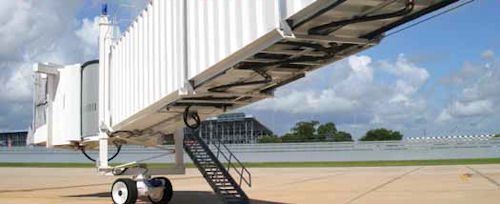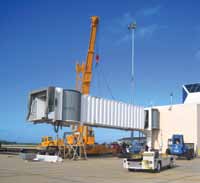 |
|
Facts & Figures Project: Passenger Boarding Bridge Refurbishment Location: Daytona Beach International Airport Cost: $1.18 million ($236,000/bridge for 5 bridges) Timeline: May 2009 – March 2010 Vendor: Ameribridge Services |
Stephen Cooke, the airport’s director of business development, says cost was a serious consideration in the decision. With quotes for new equipment ranging from $450,000 to $475,000 per bridge (including installation), refurb costs of $236,000 per bridge proved too attractive to pass up. “And we pretty much have brand new bridges,” Cooke notes.
Close to Home
The first of the five boarding bridges was removed from service in May 2009 and transported about 10 miles to a facility at the Ormond Beach Airport Business Park. That’s where crews from Ameribridge Services dismantled and refurbished it top to bottom. The last of the five will return to service in March.
Typically, bridges are broken down and shipped to the refurbishing company’s facility in Indianapolis for refurbishment. If the work is less extensive, Ameribridge sends staff to work on the bridge at the airport. “This project was unique, in that we leased a facility near the airport and sent our people in to do the work locally,” notes Ameribridge sales manager Chad Sloan.
 |
 |
 |
Keeping the work close to home also provided economic benefits to the local Daytona Beach area from lease revenue for facilities and equipment.
The airport minimized disruptions to operations by putting an extra boarding bridge into service while the five others were being refurbished. The airlines were networked to the various gates ahead of time so they could roll their computer equipment to the appropriate gate when the bridge at their usual gate was being refurbished.
Good as New
Five to six Ameribridge employees worked on the Daytona Beach bridge rehabs for ten months. It took approximately two days to take each bridge down and transport it to the Ormond Beach facility, where the three-tunnel bridges were separated into individual components.
After a bridge was disassembled, it was sandblasted, primed and repainted. Ceiling, flooring, and floorcoverings were replaced, but wallboard panels were reused to save money. Each tunnel was also outfitted with a flat roof overlay to mitigate corrosion problems from poor water drainage on the existing corrugated roofs.
“They broke the bridges down completely,” Cooke explains. “They removed all the cabling, wiring and electronics; removed the motors; sandblasted; replaced bad metal; upgraded the oriented strained board flooring, which was rotting, to marine grade plywood; installed new carpeting; replaced the motors; and put in new limit switches and weather safeguards. They are like brand new bridges.”
The biggest improvement, however, was the upgrade to an AC drive motor.
“The old bridges had horizontal DC drive motors,” says Cooke. “The new AC motors use variable speed drive. They operate much more smoothly and aren’t nearly as jerky as the DC drive. While we upgraded the console, we stayed with the existing relay logic system to keep costs down.”
The AC drive motors are also smaller and more reliable, he adds.
According to Sloan, DC motors are “extremely cost prohibitive” to replace. “A single new replacement DC horizontal drive motor costs as much as the entire AC drive conversion package,” he explains.
Before the refurbishment project, the bridges were beginning to have some maintenance problems. “Passengers don’t understand when something doesn’t work properly,” laments Cooke. “Maintenance was taking up a lot of staff time. Failures with jet pak controllers for the DC horizontal drive motors were getting to the point where we weren’t going to be able supply parts for the DC motors.”
The airport expects a lifespan of 15 to 20 years for the refurbished boarding bridges – about the same as new bridges, says Cooke, but for almost half the cost. Refurbishing also includes the environmental benefit of reusing major components.
“These refurbished bridges are great products,” Cooke says enthusiastically. “We want our equipment to be reliable and convenient for our passengers. These bridges work well and are going to create a better standard for us going forward.”


